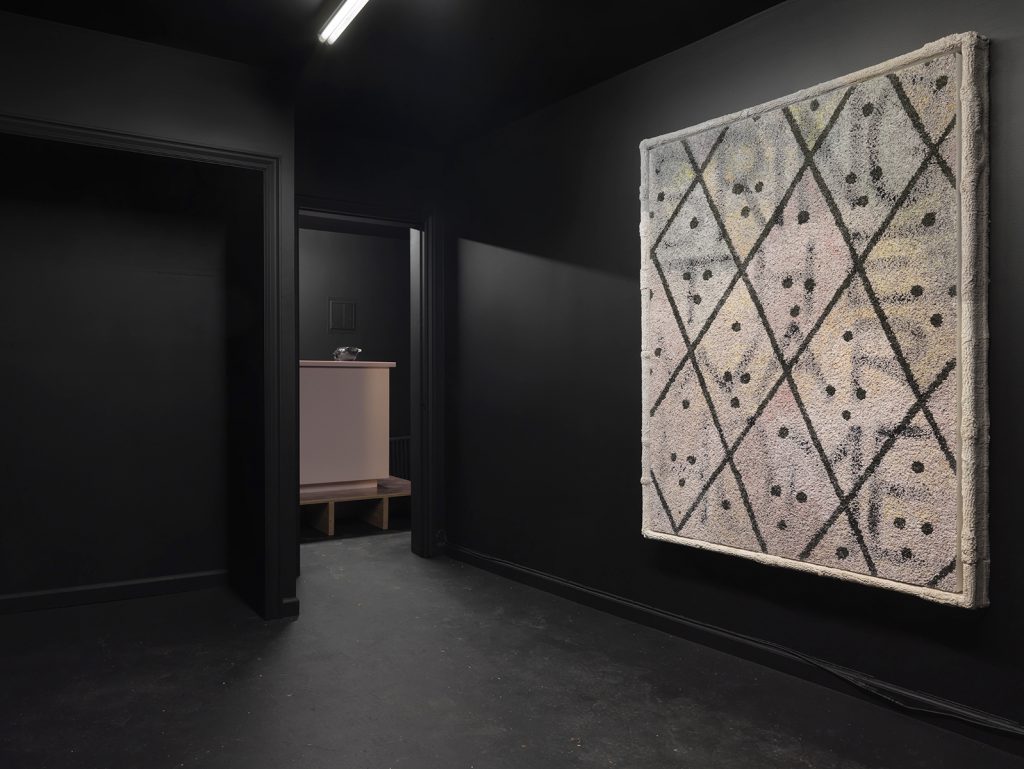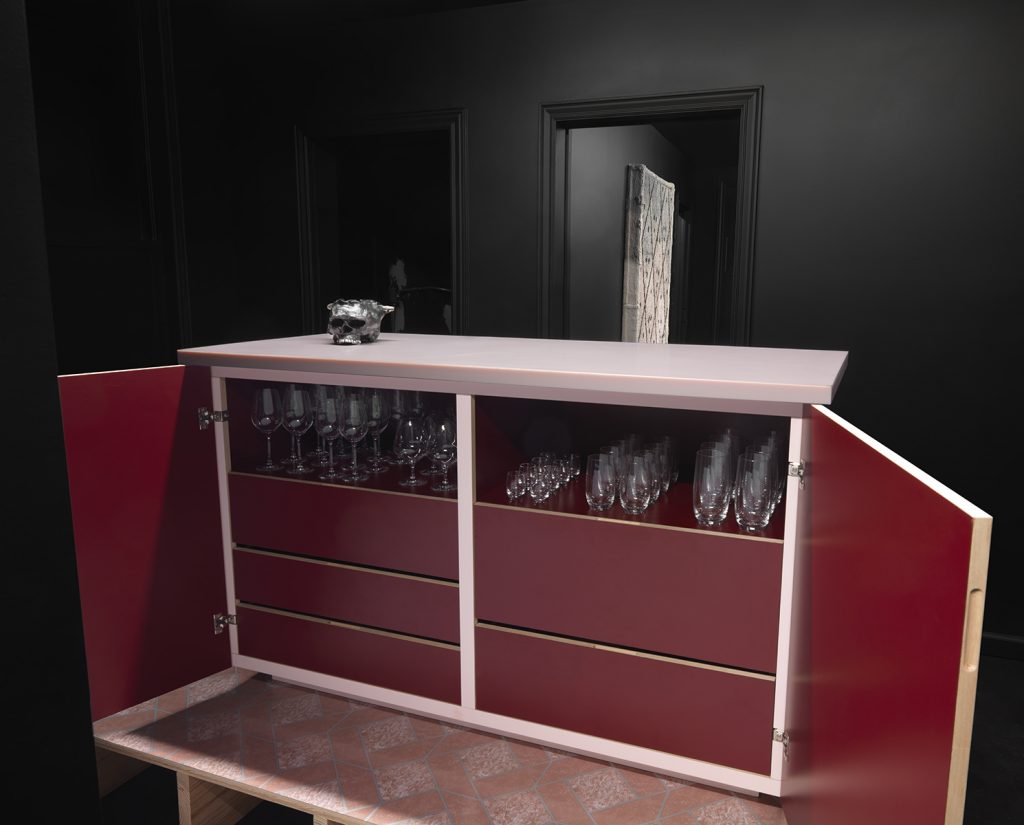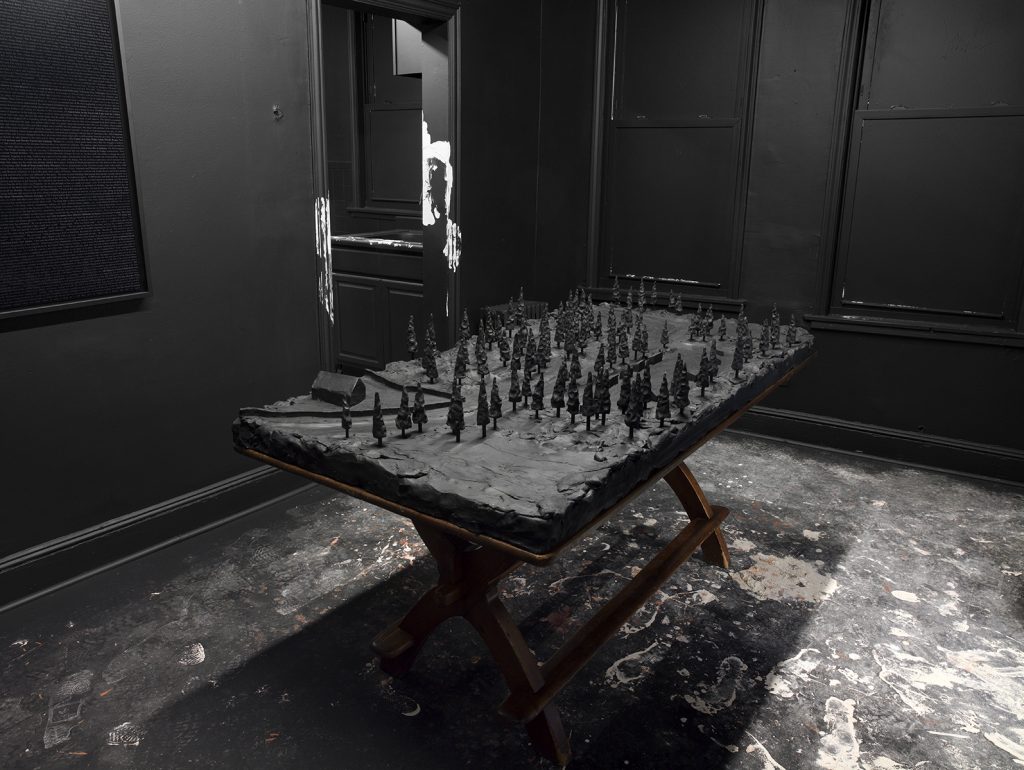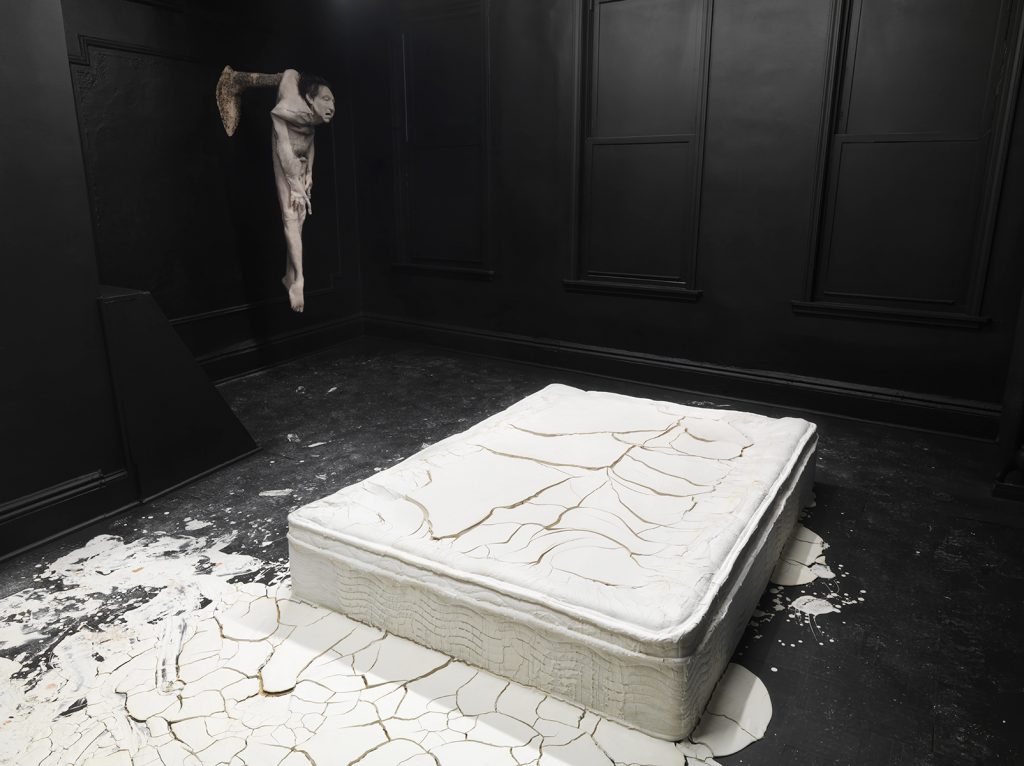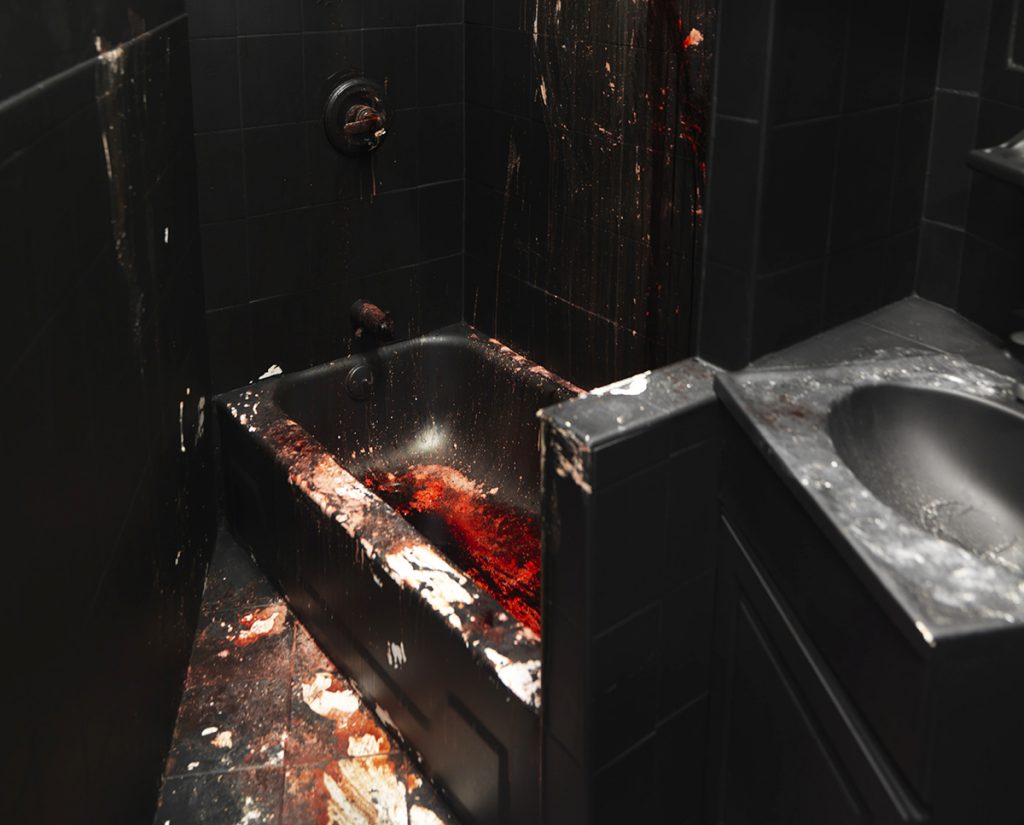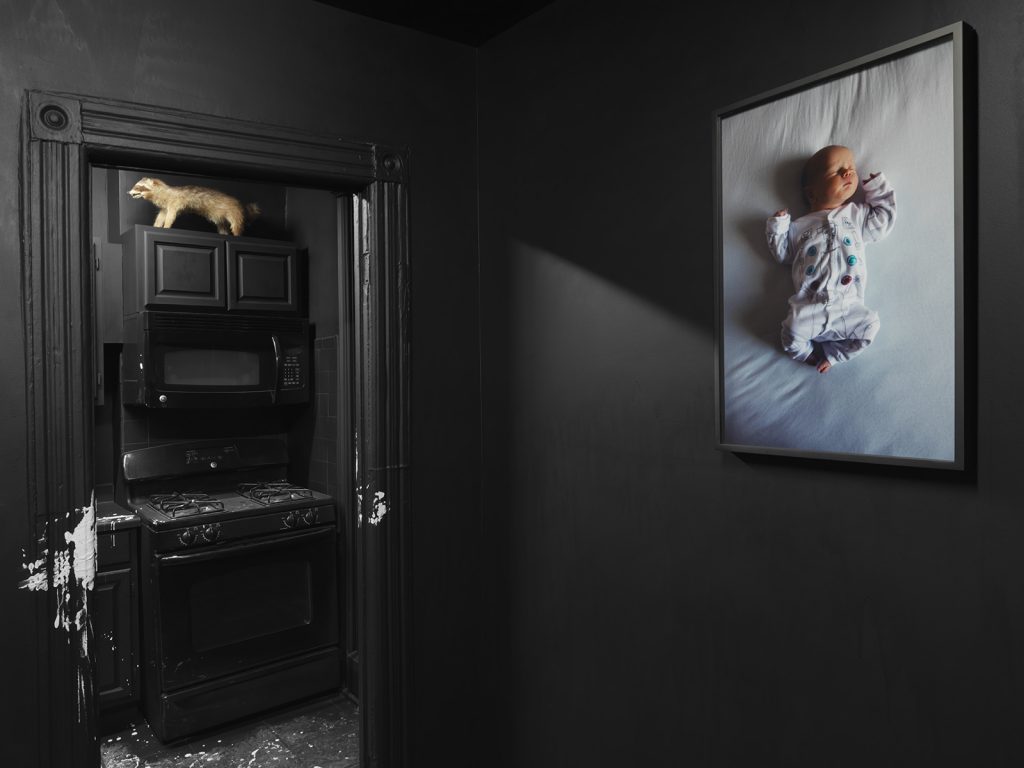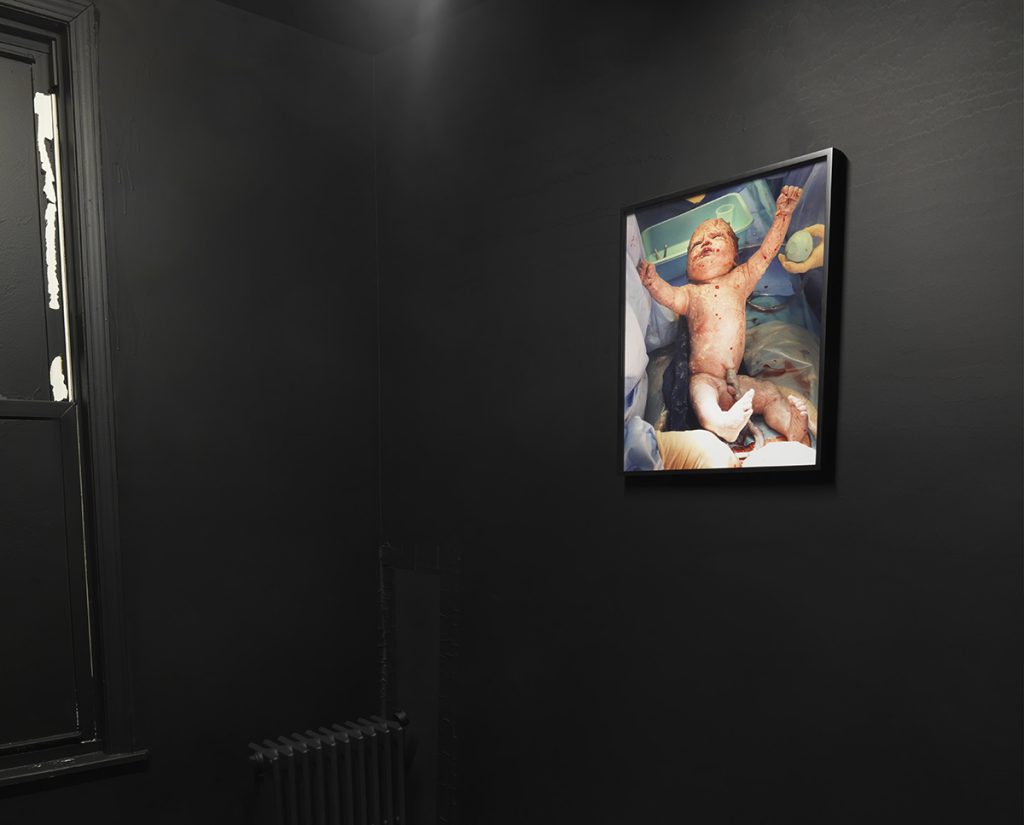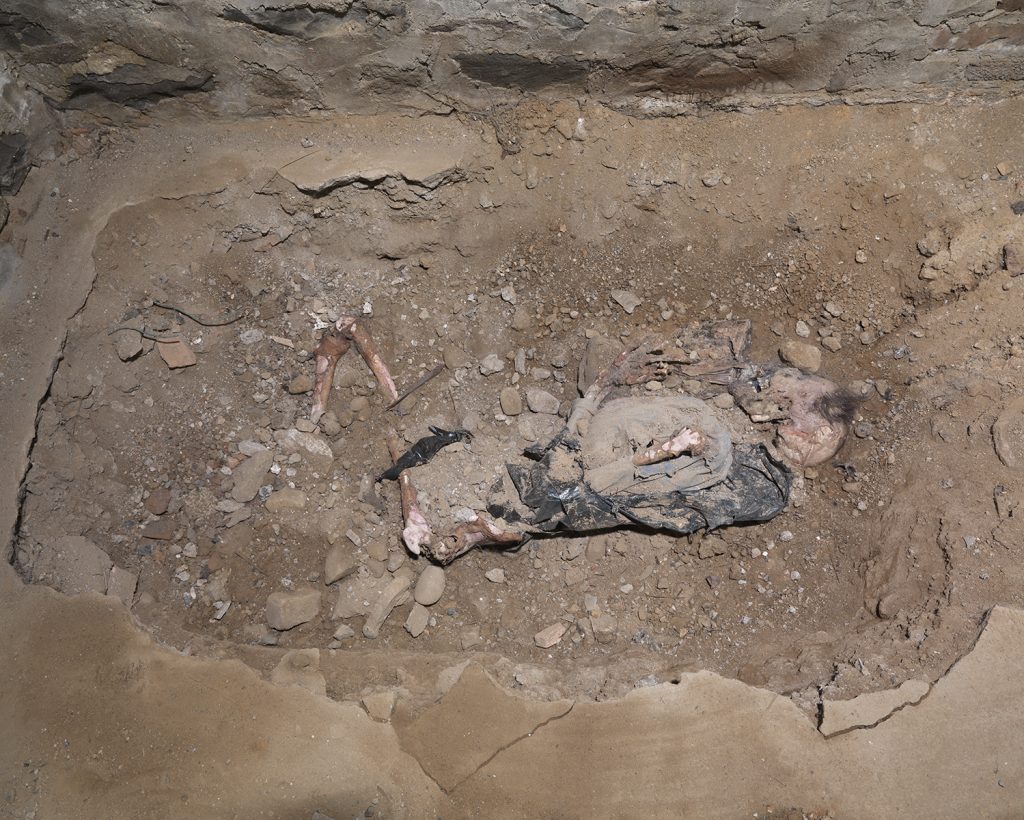
Gallery Blackhouse Artist’s Tour
Ground floor, living room 15m2, Bring The War Home
Built into the foundation of American culture, our ability to exact harm on others is directly relational to our material comfort. A disruption to the way we live may be the only way in which to make meaningful change in our disproportionate use of the world’s resources per population.
The frame and the surface of this work is cast carpet. The carpet pattern is based on my memory of the carpet in my great grandmother’s home. For many years I had a memory of myself as a child lying on that carpet, hiding under a chair. As my grandmother walked past I grabbed her ankle and she fell, breaking her hip. This led to a decline in her health and she later had a stroke and passed away. It is only within the last ten to fifteen years that I learned from my mother that this memory was a fabrication, that I had never caused an injury or fall or even hid under the chair. Regardless, the carpet pattern persists in my memory.
Ground floor, living room 12m2, Depth Hoar
The drawers of this pink cabinet contain dining utensils and a book called ‘Depth Hoar’. It features recipes for the last meal requested by inmates on Death Row. The place settings within the cabinet can accommodate any meal contained in the cookbook.
The work addresses capital punishment and the violence inherent in American culture. The concept of punishment is integral to American identity in the sense that there is no space for forgiveness or redemption. Death Row is populated by many people who have lived most of their lives in a state of poverty. The penal system is a part of the foundation of the suburban experience in the sense that this institution keeps the middle class and the poor separate. This is a method to handicap progress of people of colour stemming from slavery and segregation to this more “refined” system of institutional racism. Sharing the meals in the book is an attempt to humanise the people ordering the meals and to meditate on the inhumanity of a system only concerned with punishment.
First floor, Dining room 12m2, Nisqually Tribal community
I’ve sat in my grandparents house at this table for 15 Thanksgiving and Christmas dinners. In this work the table has been repurposed to hold a landscape, sculpted from memory, of Yelm Highway, which divided the Nisqually Tribal community from the Fort Lewis artillery range and its neighbour, JZ Night’s religious cult compound in Washington State. The depicted landscape in the model was ten miles from my childhood home and when artillery was tested at Fort Lewis we could hear the distant explosions and the windows of our living room would subtly rattle.
These sites form a triangular foundation of thought in my work. The first corner of the triangle refers to the continued institutional violence that is exacted on First Nations people in North America, the second is the expansion of military power which replicates this harm around the world, and the third is the way in which religious cults mirror much of the American experience.
First floor, bedroom 20m2, Natural History of Religion
In this room I performed a Butoh dance. Butoh is a form of Japanese dance theatre developed in the post-war years, its practitioners often covered in white body paint. I wanted the paint I used to abstract my body, to have a mud-like texture in order to accentuate the idea of filth or dirt accumulating on my flesh. We cut a section out of a mattress top and poured in 50 gallons of porcelain slip. I laid in the slip until I fell asleep and began the performance when I woke up.
The performance narrative depicted my morning ritual in the vernacular of Butoh. I woke up, got the kids up, made breakfast, took a shower, got dressed and left the house. What attracted me to Butoh is that the dancer creates the movements from their imagination, from the depths of their emotional selves. The heritage of the dance is directly tied to the bombings of Hiroshima and Nagasaki and therefore also relates to the development of American post-war suburbia whose performative reality is concerned only with surface and neglects interiority.
First floor, bathroom 5m2, Domestic Fountain Sculpture
Bathing is part of the morning ritual depicted in the Butoh performance. We retrofitted the shower so that it sprayed fake blood instead of water, like a horror movie nightmare sequence. The shower was baptismal but rather than a cleansing, it further soils me. The shower represents my complicity in the systems and ideologies which I critique but ultimately am dependent upon for my own comfort. We bought 40 gallons of fake blood which was pumped up from a huge barrel. As I showered off the porcelain slip with blood, I turned from white to deep red. As I walked out of the house into the night, I was partially naked, covered in bloody mud. People walking by on the street were horrified. I imagine their reaction was a mix of fear, disgust and surprise.
First floor, second bedroom, 9m2, Everett Coleman Jackson
In this photograph, my son Everett is wearing a onesie that my wife, Laura, and I designed for the Contemporary Arts Museum Houston. She was a technical designer and for much of her professional life she worked in fashion. The design was based on an AL7 lunar suit. I had planned to take a photo of Everett’s first breath. His birth had all kinds of unforeseen complications however, and I was not thinking about my camera when he finally arrived. The photo is him in his space suit right before we left the hospital.
First floor, second bedroom, 9m2, Flynn’s First Breath
One of the best things about being an artist is that you get to define how you see things and describe that process for other people. The reason why people like looking at art is that it posits a different way of looking at something. Artists get to share that experience of being able to see something new or in a new way. That’s why I wanted to take a picture of my son’s first breath. I love to imagine what his first breath tasted like.
When he is taking his first breath, he is not only feeling his lungs filling with air but also the subtle taste of that air… perhaps an essence of the people in the room. I think there is a mystery in these simple things. I wonder whether in that first moment, a baby knows everything and the remainder of a life lived is a slow decline to really knowing just one thing.
Basement 48m2, ‘Me, Dead at 41’
The ‘Me, Dead’ series is an annual self-portrait which I began at the age of 35. Each photograph depicts a death ritual as practised by people, around the world. I installed ‘Me, Dead at 41’ in the basement as a reference to a well-known burial method popularised by the serial killer, John Wayne Gacy, who buried his victims in the crawl space of his home in Chicago. The work addresses aspects of myself which I loathed and how I dealt with them. I wanted to ‘murder’ that part of myself, to bury those parts and leave them behind. In a way, I wanted to bury myself within myself.
We broke through the poured concrete of the basement floor, dug an 80 centimetre deep hole with a pickaxe and placed a sculpture of a skeleton dressed in my tattered and torn clothes into the dirt. In the room above the skeleton, a hole was drilled in the floor which effectively turned that room into a camera obscura. The ‘Me, Dead at 41’ edition was created by capturing the inverted image on the ceiling of the room.

